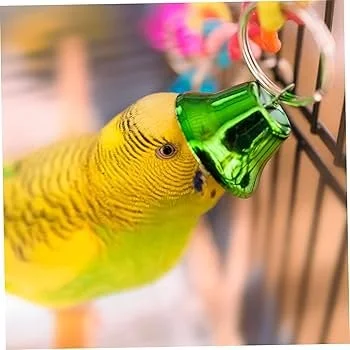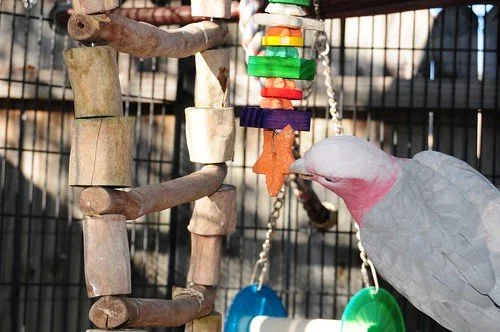A Guide to Safe Bird Toys
Some people might wonder, “Aren’t pet toys, just toys? What differentiates one brand from another?” Responsible pet owners should never think like that, and the fact that you’re reading this article tells me you’re concerned for your bird’s safety. Well done, my fellow birb parent(s)!
Safe bird toys are really essential to the wellbeing and health of your bird. Every year, many birds are injured by inferior toys, which can result in major health problems or even death. You can avoid these mishaps and guarantee the health of your feathered companion by selecting safe bird toys.
In the wild, birds are constantly searching for food and interacting with their flock. This takes up a large amount of their day. Since food is frequently readily available for our domesticated pets, a lack of stimulation can actually drive them insane. To keep your parrot engaged and mentally active, safe parrot toys are a must.
Characteristics of Unsafe Bird Toys
1) Bird toys should never have painted surfaces or use glues to hold pieces together. Even if non-toxic paints or food-grade glues are used, there is another problem that is just as serious. More natural dyes are soy based (vegetable) and are a safe colourant choice.
Paint and glues that are applied to surfaces don’t soak into surfaces like dyes do. This might attract the attention of an observant parrot during play. While our fingers are not well built to remove glue or paint, the parrot beak is capable of doing so. And if swallowed, they can be deadly even if they are non-toxic in nature. They can get lodged in the digestive system, leading to choking or serious internal blockage.
2) Strangulation is another danger. Toys with long strings or small openings can trap your bird, causing injury or suffocation. Make sure the toys you choose don’t have parts that could wrap around your bird’s neck or body.
3) Leather toys parts should be vegetable tanned only. Tanning is a soaking process that converts animal skin to leather. It is usually done with acidic chemicals, but vegetable tanned leather is soaked in tannins made from plant matter and is free of dangerous chemicals. So the next time you want to purchase a toy with some leather parts, be sure to check it is vegetable tanned.
4) Metal hardware should be stainless steel or nickel plated. Soldered (contains lead) and galvanised (zinc-coated) metals, such as chains, hooks, connectors, and other hardware are toxic to birds. Avoid easily dismantled toys, such as balsa wood and small link chain items, as well as toys with metal clips, bell clappers, or lead weights. The hardware pieces should not be removable or indigestible. Also, they should not have crevices or be shaped in ways that might get stuck on a beak or nail.
Storytime
I once went into one of those huge pet stores in the mall and came across a lovebird that was struggling to free its beak from a metal jingle bell attached to a toy. The poor baby had its beak lodged in the slit of the bell and was hanging from it. I quickly alerted the staff and they were able to safely dislodge the lovebird’s beak from that treacherous bell.
After witnessing that, it really highlighted to me that if our pet store chains could sell such potentially dangerous toys, can you imagine how many birb parents might have purchased it, unaware of its hazards? Thus, it’s important to choose safe, high-quality bird toys from brands we can trust.
Cowbell-style bells and jingle bells are toys to avoid, as well as any bell made of a metal that's toxic to birds. Jingle bells are never a safe choice because the slits in them are shaped so that round openings narrow into smaller slits, which can easily trap a toe or a beak if it slides along the slit.
Stainless Steel Bird Bell
For example, this type of bird bell has long tubes to discourage parrots from breaking off the clapper and swallowing.
The description in the photo reads:
“ 100% bird-safe stainless steel bell. The outer casing ensures safety when using the toy so your bird cannot remove the clapper from inside. Long lasting high quality stainless steel. Suitable for Greys, Amazons, Cockatoos, Macaws, etc”
5) Wood Safety is very important. Parrots are natural chewers, and this behavior is essential for their beak health. To ensure their safety, offer your feathered friend safe, untreated wood (no wood preservertives or chemicals). Avoid painted or pesticide-treated wood. Natural or bird-safe dyed wood are acceptable.
The type of wood you give your parrots matter as well. You wouldn’t want your parrot chewing on some toxic wood from their toys or perches.
Here’s a list of wood you can use and avoid:
Adapted from: https://shorturl.at/YJrW9
Disclaimer:
The internet is filled with conflicting claims about wood safety. While we've compiled this list based on available information on the internet, it's crucial to conduct thorough research before using any wood. Always verify the safety of your chosen wood through multiple reliable sources. You may use it as a handy starting guide, but it is always advisable to do further searches if you are in any doubt.
Characteristics of Safe Bird Toys
1) Non-Toxic Materials: Safe bird toys should be made from non-toxic materials. Avoid toys with lead-based paint, zinc-coated metal, or cheap plastics. Instead, look for toys made from stainless steel, untreated wood, natural fibers, and plant-based materials like seed pods. These materials are safe for birds to chew and play with.
2) Durability: Safe bird toys need to be durable to withstand your bird's strong beak and claws. Toys that break easily can create small parts that might be ingested or cause injury. Durable materials like stainless steel, thick untreated wood, and sturdy plant fibres ensure the toys last longer and stay safe.
3) Safe Design: The design of bird toys should prioritise safety. Avoid toys with long strings, thin ropes, or small openings where your bird could get trapped. Safe bird toys have secure attachments and no small parts that could be swallowed. Look for designs that encourage natural behaviours without posing risks.
4) Easy to Clean: Keeping bird toys clean is important for your bird's health. Safe bird toys should be easy to clean and disinfect. Stainless steel, hard wood, and certain plant-based materials can be wiped down or washed without damage, ensuring your bird's toys remain hygienic.
5) Encourages Natural Behavior: Safe bird toys should encourage natural behaviors like foraging, chewing, and climbing. Foraging toys made from safe materials for bird toys can hide treats and provide mental stimulation. Chew toys made from untreated wood and seed pods help keep your bird's beak healthy, and climbing toys promote physical exercise.
6) Quality and Origin: Choose toys from quality manufacturers that you can trust. Supporting reputable brands ensure that your bird gets the best and safest toys available. A few notable USA brands that produce great bird toys are, Planet Pleasures, Super Bird Creations, Bonka Bird Toys and etc. As a general rule of thumb, always make sure to inspect your new bird toys just to be extra safe.
Why It's Important to Inspect Bird Toys Every Day
Daily toy inspections for birds are crucial for their safety and happiness. Birds are curious and playful, which means their toys can quickly become worn out or damaged. Regular checks help you identify unsafe toys before they harm your feathered friend, preventing accidents and ensuring their well-being.
Adapted from: https://shorturl.at/8XhKR
In conclusion,
To keep your bird healthy and happy, choose high-quality, non-toxic materials and inspect their toys regularly. As a responsible birb parent, you can prevent accidents and keep your feathered babies engaged. So the next time you shop for bird toys, remember what to take note of!






